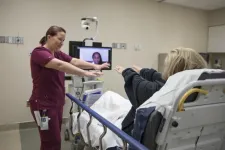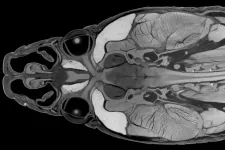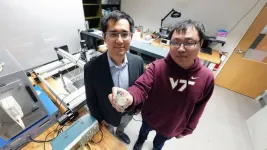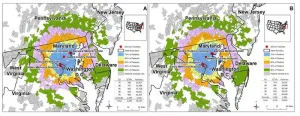(Press-News.org) A team of solar scientists have uncovered the possible originals of the engine that drives much of the sun’s volatile nature—generating the sunspots that move like storm clouds over the surface and causing the sun’s activity levels to rise and fall over 11-year cycles.
The secret behind this engine, also known as the “solar dynamo,” may be among the oldest “unsolved problems of physics,” said Benjamin Brown, a solar physicist at CU Boulder.
In new research, he and his colleagues used mathematical equations to simulate the behavior of the sun, arguing that the dynamo may begin in the star’s outermost layers—not deep in its interior as many scientists have believed for decades.
It’s a pursuit that, in many ways, started with the famed astronomer Galileo Galilei in 1612 A.D.
“Galileo first observed the sunspots 400 years ago, and he learned quite a bit about them, including how they move over the sun’s surface,” said Brown, a co-author of the research and associate professor in the Department of Astrophysical and Planetary Sciences. “But he couldn’t figure out where they came from. We’ve struggled with the question ever since.”
The researchers, led by Geoffrey Vasil of the University of Edinburgh in the United Kingdom, published their findings May 22 in the journal Nature. Co-authors of the study included Keith Julien, an applied mathematician from CU Boulder who died in April after a short illness.
The findings hinge on the dynamo, the term for the complex physics and chemistry in the sun that produce its wild magnetic fields. Earth boasts its own dynamo that powers the planet’s magnetic field—the reason why all compasses on the ground point north.
The sun’s inner workings matter a lot for people, Brown said. The sun’s dynamo generates solar storms that, among other things, pose risks to human power grids. Such storms also caused the auroras that appeared in the skies above the United States earlier this month.
For the researchers, the study represents an achievement decades in the making.
“Geoff Vasil and I have been thinking about these ideas ever since we were both grad students at CU Boulder 20 years ago,” Brown said.
Wild yet orderly
In general, scientists agree that the solar dynamo begins in the sun’s “convection zone,” or roughly the outer one-third of its interior. There, plumes of hot and charged particles, known as plasma, climb toward the surface.
While Earth’s magnetic field is mostly uniform, the churn of plasma throughout the sun’s convection zone warps and twists its magnetic field lines into a pattern that looks a like a bowl of noodles.
Despite that chaos, the solar dynamo powers behavior that is surprisingly predictable, Brown said. Every 11 years or so, the sun moves from a period of low activity, when sunspots pop up less often, to a period of frenzied activity, when sunspots abound—then it flips and starts all over again. Right now, the sun’s activity is on the frenzied side.
“You could practically set a calendar to the solar dynamo,” he said. “How is it so wild yet also so orderly?”
Spinning dancers
To find out, researchers first need to know exactly where in the sun the dynamo begins. In the 1990s, scientists proposed that the dynamo emerged roughly 130,000 miles below the sun’s surface—a theory nicknamed the “dynamo in the deep.”
That notion, however, struggles to explain the order that emerges from the sun’s chaos. Instead, Vasil, Brown and their colleagues turned to a phenomenon in physics called a “magnetorotational instability.” It’s a sort of imbalance that forms whenever magnetic fields interact with rotating plasmas where those flows move faster as you go deeper.
“It’s kind of like dance partners slinging each other around in a spin while holding arms,” Brown said.
Researchers have long examined how this phenomenon arises in the disks of hot gases that circle black holes. Its role in the sun is less clear.
In the current study, Vasil, Brown and their colleagues ran a series of calculations on computers to study how such an instability could influence the sun’s activity. They discovered that the process could easily whip up the sun’s insides to form the solar dynamo and explain how the 11-year cycles start. Those physics would also take place in the outer 10% of the sun, or a paltry 20,000 miles from the surface. The solar dynamo, in other words, might be powerful, but it’s also a little on the shallow side.
The researchers have a lot of work to do before they can fully cast off the dynamo in the deep theory. But Brown is hopeful that the study could become its own dynamo—generating a wave of new research in the field.
Vasil added that the work is a testament to his colleague and friend, Julien.
As a doctoral student at CU Boulder, “My advisors and mentors were Nic Brummell, Juri Toomre and Keith Julien,” Vasil said. “I recall first having a ‘huh, that's funny’ moment about sun's the near-surface instability one morning in 2004 while flipping through an astrophysics textbook. Keith was the first person I literally ran to tell about it. He was such a fantastic friend all these years. He supported ideas and gave encouragement to a generation of energetic young researchers, like I was back then. It's astonishing he won't be here anymore. But he was thrilled this work happened and was to be published in Nature. The silver lining is that his ideas and personality will live on in the astonishing number of people that he inspired over the years.”
END
Solar physicists unlock the key to how sunspots form—and much more
2024-05-22
ELSE PRESS RELEASES FROM THIS DATE:
Stroke-care metrics improve with stroke center certification and coordinators
2024-05-22
Key stroke-care metrics improve at telestroke hospitals with stroke center certification and stroke coordinators.
That’s what NORC researchers at the University of Chicago found when they conducted an external evaluation of the telestroke program at the Medical University of South Carolina. NORC, which stands for National Opinion Research Center, and MUSC researchers report their findings in the Journal of Stroke & Cerebrovascular Diseases.
Mithuna Srinivasan, Ph.D., principal research scientist at NORC, is the lead author of the article and MUSC telestroke and telehealth experts Christine Holmstedt. D.O., Jillian Harvey, Ph.D., ...
Young people are increasingly using Wegovy and Ozempic
2024-05-22
Public interest in weight loss drugs like Wegovy and Ozempic is surging, but national data on dispensing patterns in the United States are surprisingly scarce.
Now, a national study from Michigan Medicine shows that the use of these weight loss drugs is increasing rapidly in adolescents and young adults 12-25 years, especially females.
Using 2020 - 2023 data from a national database representing 92% of pharmacies, the study team found a 594% increase in the monthly number of adolescents and young adults using Wegovy, Ozempic, and other glucagon-like peptide-1 receptor agonists ...
UArizona Health Sciences professor uses CT network to promote public access to open science
2024-05-22
Reading about the latest scientific discovery – such as the unearthing of a fossil representing a new species of tiny dinosaur – can be fascinating. But what if it were possible to do more than just read about it? What if you could go online, download a digital model and 3D print an exact replica of that fossil within minutes of reading the news? That is the goal of the Non-Clinical Tomography Users Research Network, or NoCTURN, an international group of researchers spearheaded by theUniversity of Arizona Health Sciences, the American ...
Designing autism-inclusive healthcare environments
2024-05-22
Autism is the most common neurodevelopmental disorder in the U.S., affecting an estimated one out of 36 children. Most people with autism experience unique sensory features such as differences in reactivity to touch, sounds, and sights or difficulty managing multiple sensory inputs at the same time.
These sensory differences can make the healthcare environment — often characterized by fluorescent lights, idle waiting rooms and uncomfortable pokes and prods — difficult to navigate, preventing children with autism from getting the care they need. To change that, occupational therapists Roseann ...
Zhenhua Tian receives National Science Foundation CAREER award to develop invisible acoustic tweezers
2024-05-22
Medical procedures capable of moving cells inside the body without making incisions have unique benefits. From faster recovery times to less trauma impacting the body, the list of reasons to do surgery without scalpels is growing with the technology used to perform noninvasive treatments.
A new method that might be available in the future is coming to life through research conducted by Zhenhua Tian’s team. The assistant professor in the Department of Mechanical Engineering is using tube-shaped acoustic energy to capture tiny biological ...
Community science volunteers can set scientific world abuzz with new bumble bee sightings
2024-05-22
TORONTO, May 22, 2024 – Community science volunteers – laypeople with an interest in bees and conservation – significantly contribute to the scientific knowledge of native bumble bees across Canada and the United States, finds a new study by York University.
It’s buzz worthy confirmation that community science programs can play an important role in monitoring the changing distributions of bumble bees and more. Community scientists have importantly also detected several at-risk or endangered species in unexpected locations, including the rusty-patched bumble bee and the gypsy cuckoo bumble bee. Trained scientists often haven’t seen some ...
Proximity to a cancer center contributes to cancer stage at diagnosis, study finds
2024-05-22
Location, race and insurance status play a significant part in the odds of a patient being diagnosed with early-stage or late-stage cancer, according to a detailed medical records analysis of more than 94,000 patients with cancer by researchers at the Johns Hopkins Bloomberg School of Public Health and the Johns Hopkins Kimmel Cancer Center.
Patients who lived farther away from a facility designated a comprehensive cancer center (CCC) by the National Cancer Institute (NCI) and who received only a diagnosis or only treatment at the center had higher than average odds of a late-stage diagnosis, ...
Study suggests it may be safe to de-escalate surgery in middle-aged breast cancer patients
2024-05-22
Surgery involving sentinel lymph node biopsy for middle-aged women with estrogen receptor-positive (ER+) breast cancer may do more harm than good, according to a new study led by University of Pittsburgh and UPMC Hillman Cancer Center researchers. The team used a novel artificial intelligence pipeline developed by Realyze Intelligence, a UPMC Enterprises portfolio company, to analyze electronic health records.
The findings, published today in JCO Clinical Cancer Informatics, suggest that clinical guidelines for de-escalating surgery in women aged over 70 years with early-stage ER+ breast cancer may be safely ...
Eating more ultra-processed foods tied to cognitive decline, stroke
2024-05-22
MINNEAPOLIS – People who eat more ultra-processed foods like soft drinks, chips and cookies may have a higher risk of having memory and thinking problems and having a stroke than those who eat fewer processed foods, according to a new study published in the May 22, 2024, online issue of Neurology®, the medical journal of the American Academy of Neurology. The study does not prove that eating ultra-processed foods causes memory and thinking problems and stroke. It only shows an association.
Ultra-processed foods are high in added sugar, fat and salt, and low in protein and fiber. They include soft drinks, salty and sugary snacks, ...
What factors predict when older adults will stop driving?
2024-05-22
MINNEAPOLIS – What factors lead older adults to stop driving? A new study followed older adults who had no memory or thinking problems to examine this question. The study is published in the May 22, 2024, online issue of Neurology®, the medical journal of the American Academy of Neurology.
“Alzheimer’s disease develops over a long time—people may have a 10- to 15-year period where they have no symptoms, but the disease process is developing in the brain,” said study author Ganesh M. Babulal, PhD, OTD, of Washington University School of Medicine in St. ...





